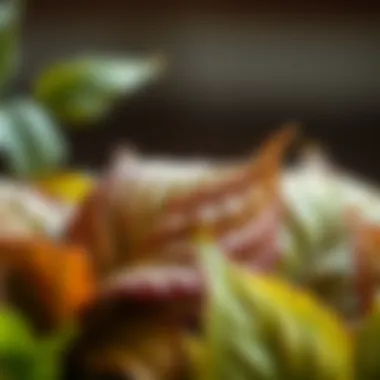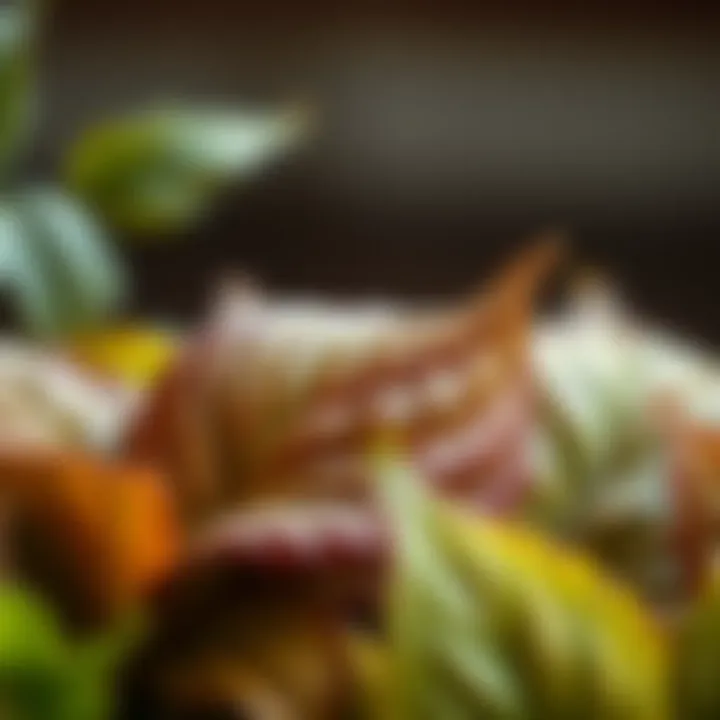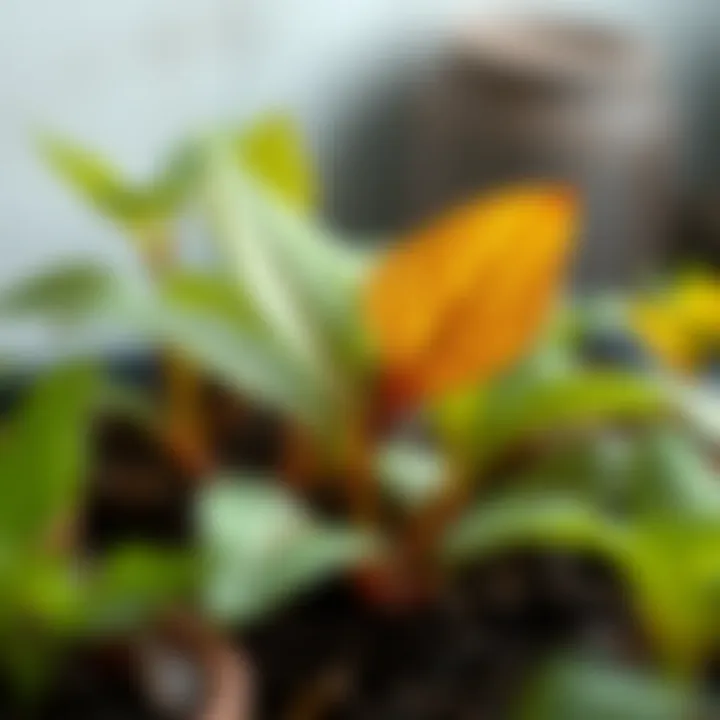Restoring Health to Plants with Brown Leaves


Intro
Taking care of plants can often feel like walking a tightrope. You nurture your greenery, talk sweetly to them, and water them diligently, yet sometimes they still droop, showing brown, distressed leaves. Many plant lovers, whether new to the hobby or seasoned veterans, face this dilemma. After all, plants can’t speak up when something’s amiss.
So, what leads to distressed foliage? There are a multitude of factors at play, ranging from environmental conditions to watering practices and disease management. Understanding these can make all the difference between watching a plant flourish or wither away.
In this comprehensive guide, we will dive into diagnosing the reasons behind the brown leaves, delve into care adjustments, and touch on techniques that work wonders in reviving ailing plants. By grasping the fundamentals of plant biology—a subject as intricate as it is fascinating—you’ll start to see your once-ailing greenery bounce back to life.
Let’s begin our journey into the leafy world of restoration.
Understanding Brown Leaves
When it comes to plant care, understanding the phenomenon of brown leaves is paramount. These discolored leaves can serve as urgent signals that something isn't quite right, whether it’s in your watering routine or the growing conditions you provide. Brown foliage doesn’t just look bad; it tells a story about your plant’s health and can help you diagnose issues before they escalate.
Brown leaves can be a plant's way of saying, 'I’m in distress.' Look at leaf color as a window into the plant's overall well-being. Healthy leaves are often vibrant and lush. When they start to turn brown, particularly at the edges or tips, immediate attention is needed. This article aims to unpack this issue, examining the underlying causes and providing remedies to fix distressed foliage.
Recognizing the importance of leaf color can guide you in identifying environmental stressors, watering mistakes, and even pest problems. Monitoring leaf health not only improves your plant's aesthetics but also equips you with the knowledge to ensure its longevity. The section that follows dives deeper into just why leaves may turn brown, unpacking reasons that many overlooked until it's too late.
Diagnosing the Problem
Diagnosing the problem is a crucial step in restoring plant health, especially when faced with distressed foliage. The underlying causes of browning leaves can range from simple watering mistakes to complex pest infestations. A careful evaluation of the plant’s environment and care routine can pinpoint issues effectively. By honing in on specific elements like environmental conditions, pests, and watering practices, plant caretakers can better understand how to reverse damage and foster healthier growth. This proactive approach is essential for those who aspire to nurture thriving plants, making diagnosis a foundational aspect of successful horticulture.
Assessing Environmental Conditions
Environmental factors play a significant role in plant health. For any plant enthusiast, understanding these elements can make or break the gardening experience.
Humidity Levels
Humidity is often a silent player in the drama of plant care. Many indoor plants thrive in high humidity, but neglecting this aspect can trigger brown leaf edges or drooping leaves. A key characteristic of humidity is its ability to influence the plant’s transpiration rates—directly affecting water absorption and nutrient transport. This is particularly true for tropical species, which prefer levels above fifty percent. The unique feature of humidity is its dynamic nature; too much can lead to fungal issues, while too little can dry plants out. Paying attention to local humidity levels can be a game changer, as it allows adjustments through humidifiers or by grouping plants to create a microclimate.
Temperature Fluctuations
Temperature fluctuation is another vital factor impacting plants. Exposure to extreme temperature changes can lead to stress, resulting in browning leaves. For most houseplants, a range of sixty to seventy-five degrees Fahrenheit is ideal. The key characteristic here is that stability is favored—plants react negatively to constant shifts. A unique feature of temperature conditions is that they can also dictate watering needs; hotter environments generally require more frequent irrigation. The advantage to monitoring temperatures means that caretakers can take preventive measures, such as relocating plants away from drafty windows or heat sources that contribute to abrupt changes.
Light Exposure
Light exposure is perhaps the most visible environmental condition affecting plant health. Different plants have varying light needs, and mismatches can easily lead to leaf distress. A significant characteristic of light is its direct role in photosynthesis, affecting growth rates and leaf quality. Providing the right amount can determine the vibrancy of green and the overall vigor of the plant. The unique benefit of understanding light requirements is that it empowers caretakers to modify positioning or optimize artificial lighting systems. However, too much direct light can scorch leaves while insufficient exposure can stunt growth; understanding this balance is paramount.
Inspecting for Pests
Pests can be unseen villains in the realm of plant care. Identifying and addressing these unwanted guests can vastly improve plant health and recovery.
Identifying Common Pests


The first step in addressing infestations is recognizing the culprits. Common pests like aphids, spider mites, and whiteflies can easily wreak havoc if left unchecked. These intruders can sap the life out of plants, leading to browning and curling leaves. The key characteristic of identifying pests lies in observing the physical symptoms on the plant; webbing, sticky residue, or visible insects can be strong indicators. An advantage of identifying pests is that it allows for timely intervention, whether through organic remedies like neem oil or other insecticides. The unique feature of this practice is the need for vigilance; being proactive can help avoid larger infestations down the line.
Signs of Infestation
Signs of infestation often manifest as physical changes in a plant’s appearance. Look for discolored leaves, spots, or sudden leaf drop to gauge the presence of pests. A prominent characteristic of these signs is their varied nature; different pests can induce different symptoms. Observing these changes promptly allows for quick action, preventing further damage. The unique feature of understanding these signs is that it equips caregivers to act before the problem escalates, preserving plant vitality and aesthetics.
Evaluating Watering Practices
Watering is a fundamental aspect of plant care. However, improper practices can lead to severe consequences, such as distressed foliage.
Understanding Soil Moisture
Soil moisture is a determinant of how well a plant can utilize water. Knowing the moisture needs of specific plants can drastically improve their chances of survival. The key characteristic here is that varying species require different water levels; for instance, succulents need dry soil while ferns like a consistently damp environment. The unique feature of monitoring soil moisture is the ability to adapt watering schedules based on seasons and plant requirements. This adaptability is crucial, as it can prevent issues like root rot or drought stress.
Determining Drainage Needs
The drainage of a pot can be a double-edged sword. While good drainage helps keep roots healthy, poor drainage can lead to waterlogging and subsequent leaf distress. The key characteristic to focus on is the type of soil and pot being used; different materials and mixes drain at different rates. Understanding drainage needs helps in selecting the right potting mix and ensuring that pots have sufficient drainage holes. An often-overlooked aspect is that proper drainage not only protects against excessive moisture but also provides a consistent environment for root growth.
In summation, diagnosing problems associated with distressed foliage is an essential skill for anyone working with plants. By carefully assessing environmental conditions, inspecting for pests, and evaluating watering practices, caretakers can create a more conducive environment for plant recovery and health.
Methods to Restore Plant Health
Restoring the health of distressed foliage requires a multi-faceted approach that addresses specific needs of the plants. By focusing on watering adjustments, light conditions, and soil quality, plant caregivers can foster an environment conducive to growth and vitality. Each of these methods brings its own set of advantages and considerations, serving as fundamental pillars to ensuring greenery thrives.
Watering Adjustments
Implementing a Watering Schedule
One key aspect of revival is establishing a watering schedule that aligns with the needs of your plants. Consistency in watering helps maintain optimal soil moisture, which in turn keeps the roots hydrated and healthy. An effective schedule can vary based on weather conditions, plant species, and seasons, but generally, sticking to regular intervals encourages steady growth.
The main characteristic of a watering schedule is its flexibility; it can adapt to the needs of many different plants. This adaptability makes it a beneficial choice in this article, as incorporating a thoughtful timetable can prevent overwatering or underwatering—two common pitfalls in plant care. By ensuring that the plants receive just the right amount of water, you maintain their vitality and prevent unnecessary stress to the foliage.
A unique feature of scheduling is that it allows you to monitor your plants more closely. You can easily spot changes or issues when you're attentive. However, be cautious about rigidity; sticking to a plan that doesn’t adapt to abrupt changes in temperature or humidity can lead to health issues. Too much of a good thing can be just as damaging as too little.
Choosing Proper Watering Techniques
When it comes to watering techniques, the method chosen plays a critical role in plant health. Watering techniques can include deep watering, misting, surface watering, and even hydroponic methods. Each technique contributes differently to overall goals of plant revival, depending on the type of foliage you’re working with.
The key characteristic of choosing the right watering technique is understanding how different plants absorb water. Deep watering allows roots to extend further into the soil, while misting is particularly beneficial for more delicate species that thrive in high humidity. Employing proper techniques makes this a popular choice for this article.
One unique feature here is that the right technique often equates to improved root health. Conversely, incorrect methods could lead to root rot or stress. It’s vital to experiment a little and observe how your plants respond. Each method has its own set of advantages: deep watering nourishes roots, while light misting can enhance humidity and prevent leaf drop. But be alert to the downfalls, as frequent misting can suffocate and promote fungus if not managed well.
Improving Light Conditions


Positioning for Optimal Growth
The placement of plants in relation to light sources is another crucial factor in their recovery. Proper positioning allows them to capture the right amount of sunlight necessary for photosynthesis, a process vital for energy production. Inadequate light can stunt growth, while too much can scorch leaves, creating a fine line to walk in caring for distressed foliage.
Highlighting the key characteristic here—the strategic positioning of plants—means that even if you are using high-quality soil or fertilizers, your plants might still falter without adequate light. This article presents this method as beneficial due to its direct impact on health and growth.
A unique aspect of positioning is the simplicity of its implementation. Moving a plant can be an effortless task without requiring any special tools—just a bit of effort and observation. However, be cautious: changes in position can leave plants temporarily stressed, especially those affected by dramatic shifts in their growth environment.
Utilizing Artificial Lighting
Artificial lighting serves as a modern solution for providing adequate light conditions. It can be particularly useful for indoor plants or in environments where natural light is limited. Using grow lights becomes essential when one seeks to replicate sunlight exposure.
The key characteristic of artificial lighting is its adaptability; it can be tailored to suit various growth stages and plant types. This makes it a valuable addition to this article. Grow lights can simulate sunlight intensity and duration, making them a possible lifesaver for struggling plants.
A unique feature of using artificial light is that it opens the door to cultivation even in less-than-ideal conditions. You can grow plants year-round, irrespective of the season outside. However, the downside might include the initial costs of equipment and the need for monitoring light duration to prevent plants from daylight stress, adding a layer of complexity to caretaking.
Enhancing Soil Quality
Choosing the Right Soil Mix
Selecting the right soil mix is fundamental in the pursuit of restoring health to distressed plants. Soil can change the way water and nutrients are absorbed, which is critical for recovery. While some plants thrive in well-draining mixes, others may require more moisture-retentive soil.
This method's key characteristic involves matching soil properties with the specific needs of the plant species. It’s a beneficial choice for this article because the right mix can dictate the success of other recovery efforts.
One unique feature about soil blends is the variety of components available—like perlite, vermiculite, or peat moss—that can provide tailored support. Such customization can yield significant advantages, enhancing drainage in heavy soils or improving water retention in sandy mixes. But be mindful: the wrong mix can lead to a host of problems, from poor drainage to inadequate nutrient supply.
Implementing Fertilization Strategies
Fertilization can be pivotal in healing a distressed plant. Nutrient deficiencies can often lead to a host of issues, and a well-thought-out fertilization strategy can make a world of difference. Organic and inorganic fertilizers each have their strengths and embedded qualities.
The key characteristic of fertilization lies in its timing and formulation. This practice runs as a popular choice for rejuvenation mentioned in this article. Regularly nourishing plants with the right balance of nutrients provides them with the essentials they often lack, especially if they have struggled with browning leaves.
One unique aspect of implementing fertilization strategies is that they can also serve as a diagnostic tool; observing how plants respond can guide you in adjusting your overall care routine. While fertilizers have clear benefits, they also come with disadvantages—too much can burn roots, and too little won’t suffice, reflecting the need for careful application based on demonstrated requirements.
Preventative Measures for Future Care
In navigating the challenges of plant care, being proactive often proves more effective than just reacting to distress signals. Implementing preventative measures helps ensure plants thrive rather than merely survive. These steps are key not just for remedying existing issues, but also for establishing a sustainable environment that prevents future troubles.
Taking the time to craft a thoughtful care regime can yield a visual feast of greenery, free from the stress of browning leaves. For enthusiasts and novices, knowing how to anticipate needs will not only enhance plant vitality but can boost the satisfaction derived from nurturing them.
Regular Monitoring and Maintenance
Establishing a Care Routine


One of the most vital components of a healthy plant life is establishing a care routine. This routine involves setting specific times for watering, fertilizing, and checking plants for health, which helps create a stable environment for growth. The key aspect of this routine is consistency. Just like how humans thrive with a daily schedule, plants benefit from predictable care.
Why is this routine a beneficial choice? Because it allows for the early detection of problems. If a plant is seen regularly, any signs of distress, like discoloration or wilting, can be spotted before they escalate into bigger issues. One unique characteristic of a care routine is how customizable it can be. You can tailor it around the plant’s specific needs, which means recognizing the signs each species provides. However, a potential disadvantage lies in the risk of neglecting plants during busy schedules, which can lead to lapses in care.
Adapting to Seasonal Changes
Another aspect of preventative measures involves adapting to seasonal changes. As the seasons transition, so do the needs of your plants. For example, succulents might require less water in the winter, while tropical plants may crave extra humidity during hot summers. Keeping a keen eye on these variations enables one to modify care practices accordingly.
The primary benefit of adapting to these changes is the enriched experience it provides—engaging with plants through different cycles can foster a deeper connection. One specific feature of this adaptability is the use of seasonal routines that cater to different types of plants you may have. Conversely, a downside could be the complexity introduced when trying to juggle differing care requirements across various species.
Understanding Plant Needs
Researching Plant Varieties
Getting acquainted with the specific needs of different plant varieties is paramount. Every variety has its own quirks regarding light preferences, watering needs, and room for growth. This research can empower caretakers to make informed decisions that directly influence plant health.
The beauty of knowing your plants rests in how enjoyable it can make the process of care. Tailored insights into how certain plants thrive can transform the experience from mundane to enthusiastic. On the other hand, a drawback may be the amount of time it takes to adequately learn each plant’s needs, especially if one has a diverse collection.
Tailoring Care to Specific Types
Once you understand various plant needs, tailoring care to specific types becomes possible. This approach is essential as it acknowledges the uniqueness of every species. Some plants may require additional nutrients while others flourish with minimal intervention. The customized attention fosters a thriving environment suited exactly to the preferences of each plant type.
The major advantage of this tailored strategy is the deeper bond formed through understanding, positively impacting both plant health and caretaker satisfaction. However, it's important to consider that this method requires careful tracking and a commitment to refining care practices regularly. Overlooking the specific needs of one plant can lead to unfortunate setbacks, undoing the benefits you’ve worked hard to create.
It is essential to anticipate the specific needs of each plant variety to ensure their long-term health and vitality.
Embracing these preventative measures and understanding each plant’s requirements dramatically increases the odds of keeping foliage vibrant and healthy.
Culmination
Reviving distressed plants is not just a matter of throwing some water on them and hoping for the best. It is an intricate dance of understanding, attention, and proactive care. By focusing on the specific challenges posed by brown leaves, plant caretakers can develop strategies that ensure healthy, vibrant foliage in the long run.
Emphasizing Continued Learning
Learning is a lifelong journey, especially in the realm of horticulture. As our understanding of plant biology evolves, so too should our methods for caring for them. It’s crucial to keep abreast of the latest trends and findings in plant care, whether through gardening forums, plant care tutorials, or even university extension programs. Many resources, like Wikipedia and Britannica, provide valuable insights that can deepen caregivers’ understanding of their plants' needs.
With the wealth of information available, it's easy to cultivate knowledge about not just the plants in your home but also about broader ecosystems. Whether you’re nurturing a rare orchid or a common pothos, educating yourself on specific care practices can make all the difference. A well-informed gardener is a much more effective gardener, after all. And it’s amazing how often little tweaks based on newfound insights can lead to big improvements in plant health.
Encouraging a Holistic Approach
Adopting a holistic approach to plant care means looking beyond the immediate symptoms of distress—like browning leaves—and considering the overall environment. The interplay between light, water, soil quality, and temperature is intricate and cannot be overlooked. Each component must work in harmony for plants to thrive.
Encouraging such a comprehensive view can lead to better outcomes. For instance, if the leaves are browning due to lack of moisture, pet owners might need to consider not just their watering schedule, but also the home's humidity levels or the type of pot used.
It's also worth recognizing that every plant species has its own quirks. For example, succulents need less frequent watering compared to ferns, which relish regular, consistent moisture. Therefore, developing an understanding of plant-specific care needs helps in creating a steadfast routine.
In summary, tackling the issue of distressed foliage is one part of a larger puzzle. By adopting a mindset of continual learning and embracing a holistic approach, plant lovers can cultivate a thriving indoor garden that flourishes beautifully, not just in spite of challenges but because of the thoughtful care provided.
Remember, each leaf holds a story of its journey and the care it receives. Amp up your understanding and watch your plants flourish.







